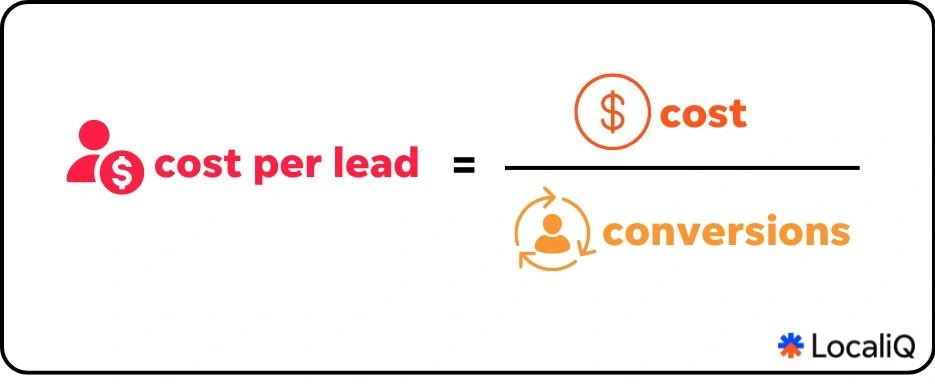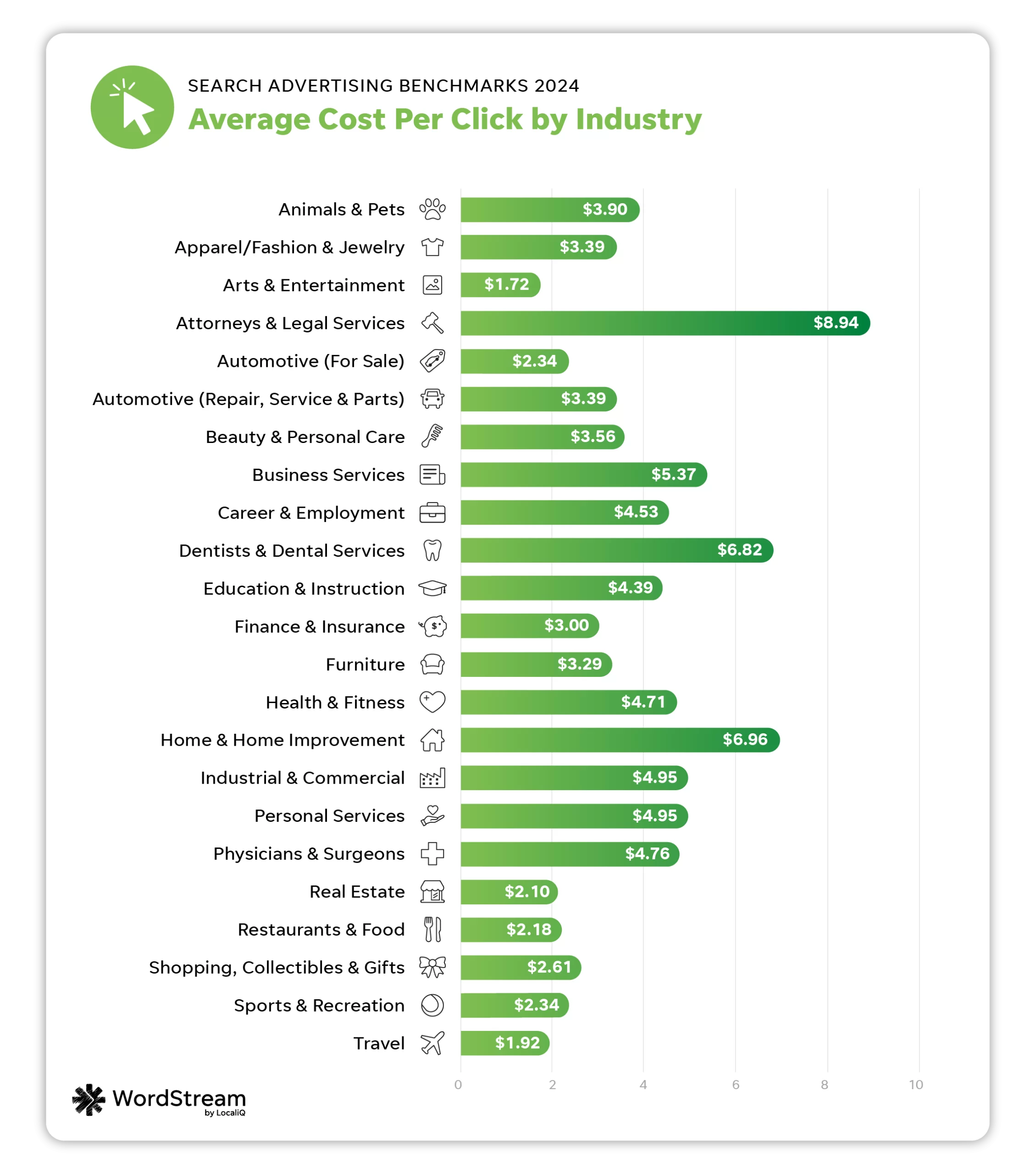Cost per lead (CPL) is a significant metric in digital advertising. For pay-per-click (PPC) and social media campaigns, businesses monitor CPL to understand whether their marketing efforts (and associated costs) are worth it.
The more expensive it is to acquire a lead, the less gross profit you’ll expect to see in the long run, as lead acquisition costs eat into your earnings. Marketers and advertisers want to find the sweet spot between investing in getting the word out about their company and ensuring those efforts are as efficient as possible in converting new prospects into leads.
So, we put together this complete cost-per-lead guide to help with that. We’ll walk through how you can calculate and lower your cost per lead in a flash.
Contents
How do you calculate cost per lead?
To identify the best ways to lower CPL, it first helps to understand how it’s calculated. The cost-per-lead formula is pretty simple.
Total cost / total number of conversions = CPL


So, if you want to lower your CPL, you have two options: aim to generate more conversions while holding your spending steady or decrease your spending while maintaining your number of conversions.
? Get more leads fast using our free Definitive Guide to Lead Generation complete with over 25 tips, ideas, and examples!
How to lower cost per lead: 7 tips
Here are seven ways to lower your cost per lead over time.
1. Take stock of your current performance metrics
The first step in finding ways to lower CPL is learning where you stand today. Crunch the numbers for each marketing or advertising campaign you have underway. This will allow you to identify any weak spots quickly. Is there a particular campaign that’s quite costly but not generating many leads? It might be time to forgo that pursuit.
On the flip side, you can ferret out opportunities for improvement. If you have a low-cost marketing tactic that generates quite a few leads already, can you optimize it further to attract even more leads?
During this process, you might wonder if your CPL is good. It’s a fair question! Any CPL greater than the cost of your product or service is too high. It can also be helpful to measure yourself against competitors by checking out CPL benchmarks by industry.


Once you’ve analyzed your campaigns and identified the ones with a noteworthy CPL—good or bad—you may wish to dig into that specific marketing channel even further.
You can look at things like CPL across devices (desktop versus mobile) or consider the parts that make up a particular advertising campaign. For example, if a PPC ad has a very poor CPL but a very high click-through rate, that’s usually an indication of a low conversion rate on the landing page. It’s worth digging into what’s causing your prospects to leave that page without converting.
2. Rethink your targeting strategy
When you run digital ads, a considerable portion of the work behind the scenes is setting your targeting strategy. For search engine marketing, you target certain keywords, while social media platforms allow you to target based on users’ demographic information.
Either way, your targeting strategy can make or break your success. Go too narrow or specific, and you severely limit the number of people who can see your ads. Plus, it can drive up the cost of your ads. But go too broad, and your ads will be served to many people who won’t find your message relevant.


Google offers examples of negative keywords.
You want to find somewhere in the middle that’s just right. With PPC ads, that might mean adding negative keywords, which excludes specific search terms from your campaign and helps you target only the most relevant audience.
For social media ads (like those on Meta), it’s about starting broad and refining as you learn more about what’s working. You may even consider creating lookalike audiences, which target Meta users who share attributes with your current customers.
3. Try A/B testing
To A/B test an ad, you run two similar versions of the same concept with a tweak in one area. For example, you might try two headlines on an ad to see which performs better.
This can help you hone in on the messaging that best resonates with your audience, which can drive down cost per lead as you learn to run more efficient, effective ad campaigns.


Some digital advertising platforms even help you automate the process. For example, Google’s responsive search ads invite you to input up to 15 headlines and four descriptions for each ad. Google then uses AI to serve up different combinations of your headline and description text to see what performs best.
Similarly, Meta has an A/B testing feature that allows you to run different permutations of your ad based on an identified hypothesis.
Take advantage of these built-in tools to test different advertising approaches and find the one that gets you the highest response rate among your target audience.
4. Align keywords with copy
This one of our seven ways to lower CPL is just as helpful for paid marketing tactics as for organic ones. Whether you’re running PPC ads or drafting your title tags and meta descriptions, aligning your copy with your audience’s search terms is wise.
The example below exemplifies this approach. These furniture companies, ranking in organic spots one through four on the Google results page, don’t use their brand name or location in the title tag. Instead, they all include some variation of the search term “small space furniture brand.”


These brands might not be as familiar to searchers, so instead of competing on name recognition, they lead with their value propositions: “You live in a small space and need furniture that will fit it? You can see from our title tag that we’re your retailer.”
When your online presence can draw searchers in with a promise that you offer the solution they need, that’s how you could lower your cost per lead. It increases the likelihood that leads will click through and make a purchase.
? Want help finding the right keywords? Use our Free Keyword Tool!
5. Strengthen your landing page
Each ad that you run should drive to a dedicated landing page. You’ve worked to tailor your ad language to suit the keywords you’re targeting perfectly, and your prospect has clicked on your link as a result of that hard work. If they land on your homepage without finding further mention of what they came here for, they can quickly get lost, confused, or distracted.
Instead, hook them in with a customized landing page that continues to address their specific need.
Let’s say you run an ad to promote an upcoming conference you’re hosting. The landing page should drive to a page about that event, with a click-to-action (CTA) to register.




In this example, the top sponsored result for the search term “conferences for investment professionals” drove to a customized landing page where the CTA invites visitors to “secure [their] seats.”
6. Incorporate a lead capture form
Once a prospect has made it all the way to your landing page, giving them a clear path to convert is another favorite way to lower CPL.
On a landing page, that means including a lead capture form. This is where you invite your prospects to enter their contact information. There are several CTAs you can try to get you there. The one that works for you will depend on your business, but you might try:
- Join our newsletter
- Register for our event
- Download our whitepaper or report
- Schedule a call
- Book a demo
You get the idea. This CTA gives your prospect a reason to want to stay in touch and opens the door for you to continue to connect with them until they’re ready to make a purchase.
? Download our free guide to the 42 best call-to-action phrases ever to get ideas for how to attract more low-cost leads!
7. Make the most of remarketing
Remarketing allows brands to stay in front of prospects who have visited their website. Maybe you didn’t convert them the first time, but remaining in their field of vision gives you a second chance.
If you’ve ever had a display ad for a product you just viewed follow you across every site you visit for the next few weeks, you’ve experienced remarketing. And if you’ve ever clicked on those ads, you know why they work.
It often takes time for a consumer to get to know, like, and trust a brand. That’s why nearly half of all transactions on a website come from returning visitors.
If you follow a new prospect around for a few weeks with your remarketing ads, they may eventually come around. And the numbers on remarketing bear that out: studies show a conversion rate that’s over 292% higher for retargeted users than it is for new faces.
Try these tactics to lower your cost per lead and save on spend
There’s no wrong answer here! Working systematically through the list and measuring each technique’s impact on your CPL can help you spot the ones most likely to drive desired results.
As your CPL drops, you can also return to the most effective tactics and look for further opportunities to refine your approach. The best thing about digital marketing is that there’s always room to improve, and you get real-time feedback to help guide your decision-making process.
If you try our ideas to lower cost per lead above but still want to uncover more ways to save on spend, see how our solutions can help you get the most bang for your marketing buck!
Here are the seven ways you can lower your cost per lead:
- Take stock of your current performance metrics
- Rethink your targeting strategy
- Try A/B testing
- Align keywords with copy
- Strengthen your landing page
- Incorporate a lead capture form
- Make the most of remarketing